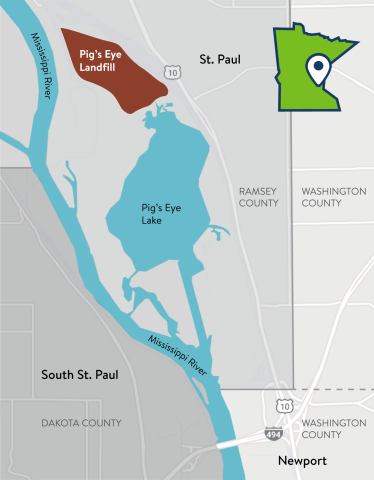Long the site of unregulated dumping of municipal, commercial, and industrial waste, Pig’s Eye Dump in Saint Paul has been slated for cleanup and restoration.
Health and environmental concerns
Despite initial cleanup efforts in the early 2000s, significant environmental concerns — including contamination from PFAS, 1,4-dioxane, metals (cadmium, copper, lead, zinc), and methane gas — remain at the site. More health-related information on these materials is available on the Minnesota Department of Health hazardous topics web page.
Our role
In 2022, the Minnesota Legislature established the Pig’s Eye Dump Task Force, an MPCA-led multi-agency task force charged with developing a plan to clean up and restore Pig’s Eye Dump. That plan will also address PFAS contamination of Battle Creek, Pig’s Eye Lake, and nearby groundwater. The task force must submit an annual report to the chairs and ranking minority members of the legislative committees and divisions with jurisdiction over the environment and natural resources.
The task force’s plan will provide recommendations on what actions should be performed for cleanup and restoration of the area. Because the remediation (cleanup) process is guided by local, state, and federal laws, the recommendations will blend the wishes of the task force and the public with government regulations. The restoration recommendations will be more directly guided by task force members and the public.
Location

Owned by the city of Saint Paul, the 200-acre Pig’s Eye Dump is located 800 feet east of the Mississippi River and immediately north of Pig’s Eye Lake, within the Mississippi River’s floodplain. Battle Creek flows through the central portion of the site. The surrounding area has several important shared uses, including Dakota homeland and site of significance, a regional park, a wastewater treatment plant, and natural areas that serve as a bird migration route.
Project information
From 1956 to 1972, more than 8 million cubic yards of municipal, commercial, and industrial waste were deposited into and on Pig’s Eye Dump. From 1977 to 1985, Metropolitan Council Environmental Services (MCES) disposed of wastewater treatment sludge incinerator ash on 31 acres of the site under an MPCA permit. In 1989, the MPCA placed Pig’s Eye Dump on the state’s list of Superfund sites.
The first phase of addressing environmental hazards posed by the waste took place from 2000 to 2005 and included the removal and disposal of batteries and drums containing hazardous waste, cleanup of lead-contaminated surface soil, removal and consolidation of waste, filling and grading of ponds, and installation of a two-foot soil cap over the dump’s waste footprint. In addition, the cleanup included efforts to limit the amount of leachate and contaminated groundwater entering Pig’s Eye Lake and Battle Creek by installing an engineered fill material into Battle Creek and Pig’s Eye Lake.
Next steps and timeline
Meetings of the task force are open to the public and will continue every two months until Jan. 2026. The cleanup and restoration plan will be completed in February 2026.
Past meetings
More information
For more detail on the contamination at Pig’s Eye Dump, view its entry on the Minnesota Groundwater Contamination Atlas.
Funding for this project was provided by the Minnesota Environment and Natural Resources Trust Fund as recommended by the Legislative-Citizen Commission on Minnesota Resources (LCCMR).